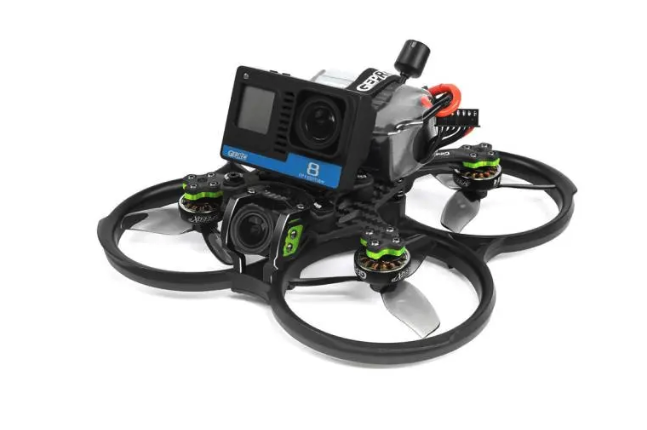Are FPV Drones Hard to Fly? An In-Depth Guide for Beginners
Contents
Understanding FPV Drones
Starting with the Basics
Choosing the Right Drone
Simulator Training
Mastering the Controls
Safety First
The Learning Curve
Joining a Community
Practice, Practice, Practice
Next Step: Choosing Your First FPV Drone
I’ve been flying FPV (First Person View) drones since 2022, and along the way I’ve researched all the ins and outs of FPV drones to see which I would prefer to fly. You have freestyle, cinewhoop, and even tiny micro FPV drones on the market. On top of learning about FPV drones, you will have to learn about video transmitters, controllers, PID tuning, goggles, batteries, and so many other little details that makeup FPV drones. In this guide, I’ll share personal insights and tips from experience to help you understand and master the art of flying FPV drones.
Understanding FPV Drones
FPV drones offer a first-person view, giving you a front-row seat to the action as if you were in the cockpit. The FPV camera is typically low quality as it’s just used to see while a GoPro or similar camera is mounted on the top of the drone capturing the action in much higher quality. A top-mounted camera is not always needed for racing or just fun, but for aerial videography it’s a must! But how hard are they to fly? Let's dive in!
Starting with the Basics
Before you soar into the sky, it's crucial to grasp the basics. FPV drones differ from traditional drones in control and perspective. You'll be wearing goggles that display live video from the drone's camera, which requires a different skill set compared to flying by looking at the drone from a distance like with a DJI Mavic-style drone. It may be disorienting when you first began to fly with goggle, but as you’ll learn shortly, you begin in a simulator to learn the controls before you even throw the headset on.
Choosing the Right Drone
For beginners, I recommend starting with a more user-friendly model. There are drones designed for newcomers to FPV flying that offer stability and straightforward controls. This initial choice can make a significant difference in your learning curve.
The Cetus FPV kit is the start kit I recommend if you have never flown a drone before. It’s a fun little drone to fly around and get use to controls before moving up a more professional setup. Think of this drone as the training wheels to whats to come!
Great starter drone to learn how to fly. Buy Here!
Now if you are planning on taking this seriously, I recommend an entirely different kit. You will have to decide whether you want to learn Freestyle or Cinewhoop flying. Freestyle tends to be much harder as these drones are more powerful. That is why I would recommend starting with a cinewhoop that has some characteristics of a freestyle drone, but the bones of a cinewhoop - the GEPRC Cinebot30.
Cinebot30 is a great starter drone!
What does the 30 mean? The number after the name of the drone for most drones indicates the prop size and in turn the size of the drone. The GEPRC Cinebot30 is a 3-inch cinewhoop which is small, but it does have a lot of power to make it fly somewhat like a freestyle drone. Keep in mind most cinewhoops are all the same with slightly different motors & flight controllers.
Simulator Training
One of the best ways to start is with an FPV drone simulator. These programs allow you to practice on your computer using the actual transmitter. It's a risk-free way to get a feel for the controls and flying dynamics without the worry of crashing your drone. I tell people to spend at least 10-20 hours in the simulator, especially if they are trying to fly acro (Manual) mode. Trust me you do want to fly in acro mode! Here are a few drone simulators where you can use your RC controller.
Price: $19.99
Note: I used this one and learned very quickly.
DRL Sim 3.0 Drone Racing Simulator
Price: $9.99
Price: Free
Price: $14.99
Mastering the Controls
The key to mastering FPV flying is understanding and becoming comfortable with the controls. Practice hovering, gentle turns, and maintaining altitude before progressing to more complex maneuvers. Ever little movement is exaggerated by the controller so make the slightest movements when flying. Patience and practice are your best allies here.
Safety First
Always prioritize safety. Choose an open, obstacle-free area for your initial flights. I recommend finding a park or an empty soccer/football field to start. This gives you the most amount of room in case of any problems. Understand and follow local regulations regarding drone flying to ensure a safe and legal flying experience.
The Learning Curve
Yes, FPV drones can be challenging at first, especially if you're new to drone flying. However, with patience, practice, and the right approach, you'll find that flying FPV drones is incredibly rewarding and a lot of fun. It took me about 2 months to fly in Acro mode, but I was in the simulator for at least 10 hours before starting. The sense of freedom and excitement when you navigate through the air is unparalleled.
Joining a Community
Joining FPV flying communities, either online or locally, can be immensely helpful. Experienced pilots can offer advice, tips, and support as you learn. Plus, it's a great way to make friends who share your interest. Don’t forget I do offer mentorships if you are interested in some 1-on-1 training (virtually)!
Practice, Practice, Practice
There's no substitute for practice. The more time you spend flying, the better you'll become. Start with short, simple flights and gradually challenge yourself with more complex routes and maneuvers.
FPV drone flying is an exciting hobby that combines technology, skill, and a bit of adrenaline. While it can be challenging at first, it's definitely achievable with the right approach and practice. So, are you ready to take the plunge into the world of FPV drones? Get ready to spread your wings and explore the skies like never before!
Next Step: Choosing Your First FPV Drone
Stay tuned for my next section where I'll guide you through selecting your first FPV drone, tailored to your skill level and interests. Let's embark on this thrilling journey together!



